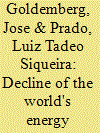| Srl | Item |
| 1 |
ID:
118823


|
|
|
|
|
| Publication |
2013.
|
| Summary/Abstract |
The world's primary energy consumption in the last 40 years has been increasing at 2.2%/year while GDP growth has been 3.4%/years over the same period. The decline of the energy intensity (I=E/GDP) has been, therefore, of 1.2%/year. In order to reduce the world's consumption growth proposal have been made to reduce the world's energy intensity by 40% by 2030 which corresponds to a reduction of 2.5%/year, roughly the double of the historical decline. Our analysis shoes that such goal could only be achieved by an unprecedented reduction of the energy intensity of "services" (which represent less than half the world energy consumption) since energy intensity of industry has remained practically constant in the last 40 years.
|
|
|
|
|
|
|
|
|
|
|
|
|
|
|
|
| 2 |
ID:
103488


|
|
|
|
|
| Publication |
2011.
|
| Summary/Abstract |
Energy intensity of the total primary energy supply (TPES), total final energy consumption (TFC) and LOSSES in the conversion from TPES to TFC were analyzed for the World, OECD and Rest of the World (ROW) countries. LOSSES increased significantly for all groups of countries due to the increase of electricity production from coal in the period studied (1971-2008). Electricity share final consumption almost doubled, increasing from 8.8% to 17.2% in the period studied. However the energy intensity of LOSSES remained practically constant, which reflects the fact that the efficiency of electricity generation from coal (the main source of electricity) remained practically constant in that period. Despite the attractiveness of end-use devices running on electricity such as computers, which is typical of modern societies, the CO2 emissions are bound to increase unless coal is replaced by less carbon emitting sources such as natural gas, renewables and nuclear energy.
|
|
|
|
|
|
|
|
|
|
|
|
|
|
|
|